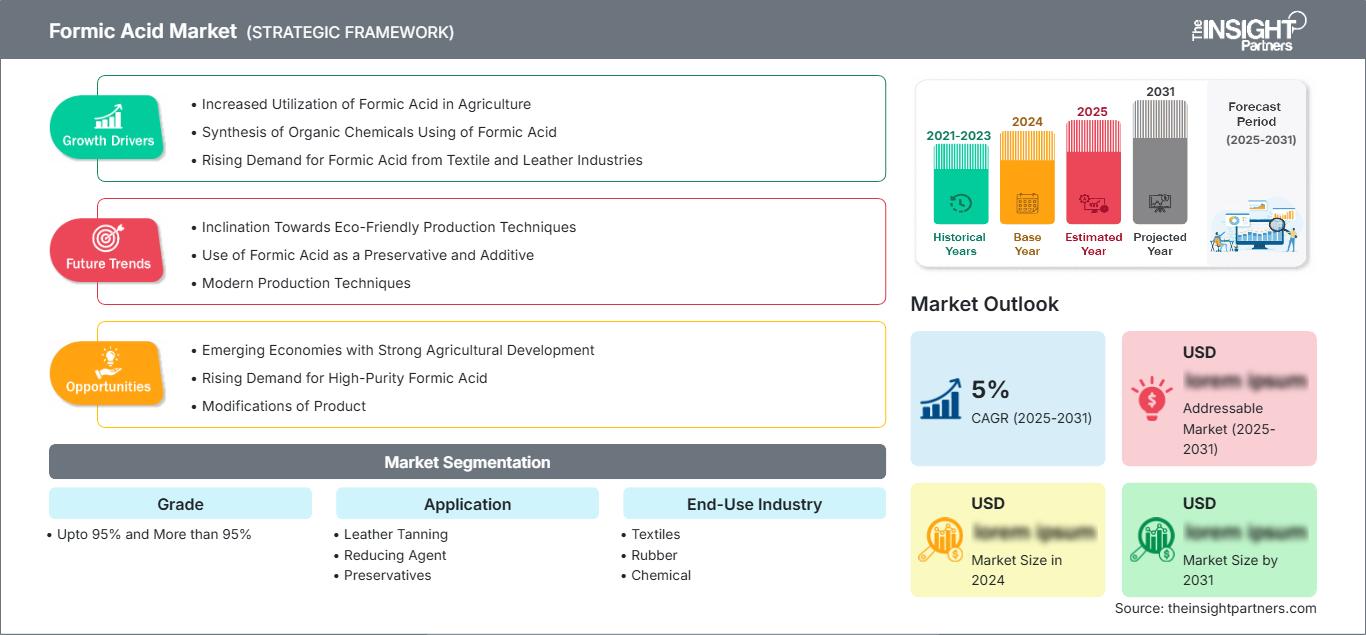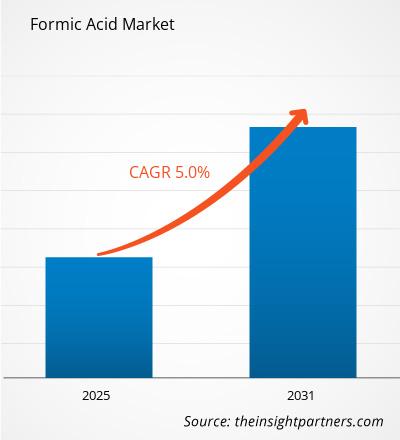Le marché de l'acide formique devrait enregistrer un TCAC de 5 % entre 2025 et 2031, avec une taille de marché passant de XX millions de dollars américains en 2024 à XX millions de dollars américains d'ici 2031.
Le rapport est segmenté par qualité (jusqu'à 95 % et plus de 95 %). Il présente également une analyse basée sur l'application (tannage du cuir, agent réducteur, conservateurs, fluides de forage, produits intermédiaires et autres) et l'industrie d'utilisation finale (textile, caoutchouc, chimie, transformation alimentaire, pétrole et gaz, agriculture et autres). L'analyse mondiale est ensuite ventilée au niveau régional et par principaux pays. La taille du marché et les prévisions aux niveaux mondial, régional et national pour tous les segments de marché clés sont couvertes dans le cadre du rapport. Le rapport indique la valeur en USD pour l'analyse et les segments ci-dessus. Français Le rapport fournit des statistiques clés sur l'état du marché des principaux acteurs du marché et offre des tendances et des opportunités de marché.
Objectif du rapport
Le rapport sur le marché de l'acide formique de The Insight Partners vise à décrire le paysage actuel et la croissance future, les principaux facteurs moteurs, les défis et les opportunités. Cela fournira des informations à diverses parties prenantes commerciales, telles que :
- Fournisseurs de technologies/Fabricants : Pour comprendre la dynamique évolutive du marché et connaître les opportunités de croissance potentielles, leur permettant de prendre des décisions stratégiques éclairées.
- Investisseurs : Pour réaliser une analyse complète des tendances concernant le taux de croissance du marché, les projections financières du marché et les opportunités qui existent tout au long de la chaîne de valeur.
- Organismes de réglementation : Pour réglementer les politiques et surveiller les activités du marché dans le but de minimiser les abus, de préserver la confiance des investisseurs et de maintenir l'intégrité et la stabilité du marché.
Segmentation du marché de l'acide formique Grade
- Jusqu'à 95 % et plus de 95 %
Application
- Tannage du cuir
- Agent réducteur
- Conservateurs
- Fluides de forage
- Intermédiaires et autres
Industrie d'utilisation finale
- Textiles
- Caoutchouc
- Produits chimiques
- Transformation des aliments
- Pétrole et gaz
- Agriculture et autres
Géographie
- Amérique du Nord
- Europe
- Asie-Pacifique
- Amérique du Sud et centrale
- Moyen-Orient et Afrique
Vous bénéficierez d’une personnalisation sur n’importe quel rapport - gratuitement - y compris des parties de ce rapport, ou une analyse au niveau du pays, un pack de données Excel, ainsi que de profiter d’offres exceptionnelles et de réductions pour les start-ups et les universités
Marché de l'acide formique: Perspectives stratégiques

- Obtenez les principales tendances clés du marché de ce rapport.Cet échantillon GRATUIT comprendra une analyse de données, allant des tendances du marché aux estimations et prévisions.
Facteurs de croissance du marché de l'acide formique
- Utilisation accrue de l'acide formique en agriculture : Son utilisation accrue, notamment comme conservateur de l'ensilage et de l'alimentation animale, est l'un des principaux facteurs de croissance du marché de l'acide formique. Il contribue également à améliorer la valeur nutritionnelle des aliments en réduisant leur altération, un aspect essentiel pour la santé et la productivité animales. L'augmentation de la consommation de viande et de produits laitiers à l'échelle mondiale stimule la recherche d'additifs alimentaires efficaces, et donc le marché de l'acide formique.
- Synthèse de produits chimiques organiques à l'aide d'acide formique : La synthèse d'autres produits chimiques tels que le méthanol, l'acide acétique et divers produits chimiques organiques implique l'utilisation d'acide formique. Ses propriétés chimiques, qui permettent son utilisation comme agent réducteur ou catalyseur, sont nécessaires dans les procédés de fabrication de produits chimiques. La croissance des activités de fabrication de produits chimiques, due à l'industrialisation croissante et à la consommation croissante de produits chimiques de spécialité, contribue également à la croissance du marché de l'acide formique.
- Demande croissante d'acide formique dans les industries du textile et du cuir : Les industries du textile et du cuir sont également de grandes consommatrices d'acide formique, car il s'agit d'un agent essentiel dans les processus de teinture, de finition et de tannage. L'augmentation de la consommation de textiles et de cuirs de qualité, ainsi que l'essor du secteur de la mode, devraient entraîner une augmentation des ventes d'acide formique. Les fabricants souhaitant améliorer la qualité et la résistance des produits disponibles, la demande en acide formique dans ces industries devrait également augmenter.
Tendances futures du marché de l'acide formique
- Inclination vers des techniques de production respectueuses de l'environnement : On observe une tendance croissante vers des techniques de production respectueuses de l'environnement sur le marché de l'acide formique. À cet égard, les fabricants appliquent de plus en plus fréquemment les principes de la chimie verte pour réduire leurs effets néfastes sur l'environnement. Cela comprend la valorisation des déchets de procédé pour produire de l'acide formique biosourcé à partir de cultures non alimentaires et de déchets agricoles, dans le cadre d'objectifs mondiaux de durabilité et comme moyen d'éliminer la dépendance aux combustibles fossiles.
- Utilisation de l'acide formique comme conservateur et additif : Les récents développements technologiques rendent l'utilisation de l'acide formique plus efficace dans divers secteurs. Par exemple, de meilleures applications sont développées pour faciliter son utilisation comme conservateur et additif. De plus, ces innovations améliorent les performances des produits et réduisent les dépenses des fabricants.
- Techniques de production modernes : L'introduction de la production grâce aux technologies numériques et à l'automatisation a rapidement transformé l'industrie de l'acide formique. La fabrication devient plus intelligente, avec davantage de procédés de fabrication, de matériaux et de produits intégrant des technologies telles que la surveillance des processus de production et l'analyse des données. On prévoit que cela améliorera également l'efficacité du processus de production tout en réduisant les coûts associés au gaspillage.
Opportunités du marché de l'acide formique
- Économies émergentes à fort développement agricole : Les économies émergentes où l'industrialisation et le développement agricole sont en pleine croissance offrent un fort potentiel de croissance sur le marché de l'acide formique. Les entreprises pourraient envisager de conclure des alliances stratégiques et des fusions-acquisitions pour pénétrer ces secteurs en raison de l'utilisation croissante de l'acide formique dans les industries agricoles, textiles et chimiques de ces régions.
- Demande croissante d'acide formique de haute pureté : L'acide formique de haute pureté est de plus en plus demandé pour des applications spécifiques telles que les produits pharmaceutiques et l'électronique, entre autres. Par conséquent, les producteurs peuvent se lancer dans la production d'acide formique de haute pureté pour combler ces lacunes existantes sur le marché. De telles initiatives stratégiques peuvent offrir de nouvelles perspectives de génération de revenus et d'avantage concurrentiel.
- Modifications de produits : Il existe des possibilités, sous forme de lacunes du marché, de modifications de produits conformément aux formulations de produits axées sur l'innovation, principalement lorsqu'il est nécessaire de remplacer les produits habituels par des produits plus écologiques et plus sûrs. Ainsi, grâce à des efforts sous forme de financement supplémentaire consacrés au développement de nouveaux produits, il sera possible pour les entreprises de proposer de nouveaux types de produits qui non seulement seront conformes aux exigences réglementaires, mais répondront également aux demandes du marché en matière de produits respectueux de l'environnement. Cette théorie de l'innovation se concentre sur l'extension du marché du produit pour lequel de tels changements sont effectués, en particulier dans le cas de l'acide formique qui peut être utilisé dans plusieurs nouvelles applications.
Aperçu régional du marché de l'acide formique
Les tendances régionales et les facteurs influençant le marché de l'acide formique tout au long de la période de prévision ont été analysés en détail par les analystes de The Insight Partners. Cette section aborde également les segments et la géographie du marché de l'acide formique en Amérique du Nord, en Europe, en Asie-Pacifique, au Moyen-Orient et en Afrique, ainsi qu'en Amérique du Sud et en Amérique centrale.
Portée du rapport sur le marché de l'acide formique
| Attribut de rapport | Détails |
|---|---|
| Taille du marché en 2024 | US$ XX million |
| Taille du marché par 2031 | US$ XX Million |
| TCAC mondial (2025 - 2031) | 5% |
| Données historiques | 2021-2023 |
| Période de prévision | 2025-2031 |
| Segments couverts |
By Note
|
| Régions et pays couverts | Amérique du Nord
|
| Leaders du marché et profils d'entreprises clés |
|
Densité des acteurs du marché de l'acide formique : comprendre son impact sur la dynamique des entreprises
Le marché de l'acide formique connaît une croissance rapide, portée par une demande croissante des utilisateurs finaux, due à des facteurs tels que l'évolution des préférences des consommateurs, les avancées technologiques et une meilleure connaissance des avantages du produit. Face à cette demande croissante, les entreprises élargissent leur offre, innovent pour répondre aux besoins des consommateurs et capitalisent sur les nouvelles tendances, ce qui alimente la croissance du marché.

- Obtenez le Marché de l'acide formique Aperçu des principaux acteurs clés
- Analyse historique (2 ans), année de base, prévision (7 ans) avec TCAC
- Analyse PEST et SWOT
- Taille du marché Valeur / Volume - Mondial, Régional, Pays
- Industrie et paysage concurrentiel
- Ensemble de données Excel
Rapports récents
Rapports connexes
Témoignages
Raison d'acheter
- Prise de décision éclairée
- Compréhension de la dynamique du marché
- Analyse concurrentielle
- Connaissances clients
- Prévisions de marché
- Atténuation des risques
- Planification stratégique
- Justification des investissements
- Identification des marchés émergents
- Amélioration des stratégies marketing
- Amélioration de l'efficacité opérationnelle
- Alignement sur les tendances réglementaires




















 Obtenez un échantillon gratuit pour - Marché de l'acide formique
Obtenez un échantillon gratuit pour - Marché de l'acide formique